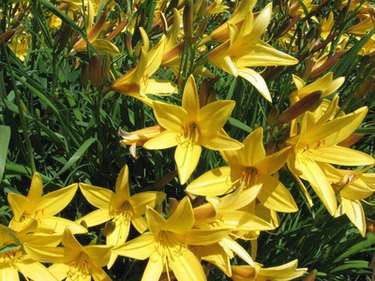
Historically, the lily family of plants was considered to be extremely broad, encompassing thousands of species and hundreds of genera. In contemporary times, taxonomists have reduced the Liliaceae family to about 16 genera and 650 species, notably kicking out the previously included bunchflower, amaryllis and asparagus families. Still, the lily family of plants is one of the largest in the plant kingdom, with members growing in all temperate regions of the planet. The lily family includes some of the most widely grown and most admired flowers, among them true lilies and tulips as well as some familiar edible and medicinal plants.
Lily Family Characteristics
Video of the Day
While the lily family of plants includes hundreds of species, they all share some common characteristics. They are monocotyledons, meaning they are plants with seeds containing a single embryonic leaf, and almost all rise from a bulb or underground stem. Lily family flowers are typically showy to attract insect pollinators, and their flowers have three sepals and three petals, all identical in size, shape and color. They feature six stamens and a pistil with a three-parted stigma.
Video of the Day
Leaves of plants in the lily family are typically flat and plain with parallel rows of veins. Leaves are usually present at the base of the plant and are arranged alternately or in a whorl pattern. Fruits of plants in the lily family are capsules or berries.
Lily Family Flowers
Flowers in the lily family are mostly colorful, large and showy, which makes them popular with gardeners and florists. Their flowers are usually trumpet-shaped or funnel-shaped with a nodding posture and radial symmetry. The Lilium genus consists of the true lilies – tall, fragrant perennials with big, brightly colored blooms that flower in late spring and summer. Some popular varieties are Asiatic, Oriental and Easter lilies, which have very large flowers in many colors and are hardy and easy to grow.
Tulips are also in the lily family and are also characterized by big, colorful flowers at the end of a single stem. Fritillaria, another genus of flowering plant in the lily family, has plants that closely resemble true lilies. They have a distinctive appearance with bicolored petals in a pretty checkered pattern. The woodland species lily of the valley, which features several delicate, bell-shaped white flowers on a spike, was historically (but no longer) classified as a member of the lily family of flowers. The same is true of hyacinths and amaryllis.
Edible Members of the Lily Family
Lily bulbs are edible and share the starchy texture of other root vegetables. They are widely eaten in China, Korea, Japan and other Asian countries. The Lilium brownii, Lilium dauricum and Lilium pumilum varieties are widely cultivated for consumption.
The Asparagales order of plants was formerly classified as part of the broader lily family. It's not uncommon, therefore, to see references to members of the Allium genus, which includes garlic, onions, leeks and chives, as part of the lily family. The Asparagales order also includes asparagus, vanilla and agave, the plant from which mezcal is distilled in Mexico. The Smilacaceae family was historically considered part of the lily family too, although now it stands alone. This family includes the sarsaparilla plant, which is used as a traditional medicine in Mesoamerica and is used globally for flavoring foods.
Medicinal Members of the Lily Family
Lily bulbs are used in traditional Chinese medicine. They are often added to expectorant medicines to treat coughs and congestion.
Another genus of the Asparagales order, which is often incorrectly referred to as part of the lily family, is the Aloe genus. This includes Aloe vera, a common natural ingredient in skin care and sun care products.